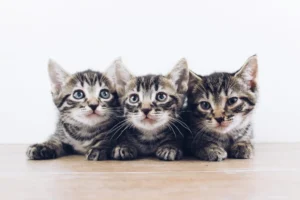Cats are known for their stealthy and quick hunting abilities, but have you ever wondered why they hunt so quickly? Let’s explore the reasons behind this fascinating behavior.
Cats hunt quickly mainly due to their evolutionary adaptations as predators, their need to conserve energy, and their hunting strategies. Now, let’s delve into more specific reasons why a cat exhibits fast hunting behavior.
Instinctual Hunting Skills
Cats are natural-born hunters, with instincts that drive them to track and capture prey quickly and efficiently. This instinctual behavior dates back to their wild ancestors, where hunting was essential for survival. Domestic cats retain this hunting prowess, often displaying impressive speed and agility when stalking their prey.
One key aspect of a cat’s hunting instinct is their incredible focus. When a cat locks onto a target, whether it be a toy or a real-life critter, they enter a state of intense concentration, carefully calculating their next move. This intense focus allows them to move swiftly and decisively, increasing their chances of a successful catch.
Another factor that contributes to a cat’s speedy hunting skills is their remarkable pouncing abilities. Cats are built for explosive bursts of energy, enabling them to launch themselves towards their prey with lightning-fast reflexes. This quick and precise movement is crucial for catching fast-moving targets, showcasing their innate hunting prowess.
In addition to their physical capabilities, cats rely on their acute senses to aid them in hunting. Their keen sense of sight, hearing, and smell help them detect and track prey efficiently, allowing them to move swiftly and silently towards their target. This heightened sensory awareness plays a vital role in their ability to hunt quickly and effectively.
Overall, a cat’s instinctual hunting skills are a combination of their predatory nature, acute senses, and agile reflexes, all working together to ensure swift and successful hunting endeavors.
Efficient Energy Use
Hunting quickly not only satisfies a cat’s natural instincts but also serves a practical purpose in conserving energy for other essential activities. Cats are obligate carnivores, meaning they require a diet primarily composed of animal protein to thrive. By hunting efficiently, cats can secure their next meal without expending unnecessary energy, ensuring they have the sustenance needed to support their active lifestyle.
In the wild, hunting can be a physically demanding task, requiring stamina and agility to chase down prey. By hunting quickly and effectively, cats can minimize the amount of energy expended during the hunt, maximizing their success rate while conserving valuable energy reserves for future endeavors.
Moreover, hunting serves as a form of mental stimulation for cats, engaging their natural instincts and providing a sense of fulfillment. Through quick and engaging hunting activities, cats can satisfy their need for physical and mental stimulation, leading to a healthier and happier feline companion.
Ultimately, by hunting quickly and efficiently, cats can fulfill their instinctual drive to hunt while conserving energy for survival and overall well-being. This balance of instinct and practicality contributes to their success as skilled predators in the animal kingdom.
Ambush Predators
Cats are swift hunters due to their nature as ambush predators. They rely on surprise attacks rather than speed to catch their prey. This hunting style requires them to move quickly and efficiently to ensure their target doesn’t escape. Cats have developed sharp instincts and reflexes to pounce on unsuspecting prey in a matter of seconds, making them successful hunters in the wild. Their ability to blend in with their surroundings and move silently further enhances their ambush tactics, allowing them to catch their prey off guard.
Enhanced Senses
A cat’s acute senses contribute significantly to their speedy hunting abilities. Their keen eyesight allows them to detect even the slightest movements, helping them spot potential prey from a distance. Additionally, their exceptional hearing helps them locate small animals rustling in the undergrowth. Combined with their sharp sense of smell, which allows them to track prey based on scent cues, cats have a comprehensive sensory toolkit that aids them in hunting swiftly and effectively. These heightened senses give cats a strategic advantage in the hunt, allowing them to make split-second decisions and execute precise movements to secure their next meal.
Unique Insight: Cats also possess specialized whiskers that are sensitive to slight changes in the environment. These whiskers help them navigate in the dark and gauge the size of openings, enabling them to move swiftly and confidently during the hunt.
Adaptations for Survival
Cats are natural-born hunters, equipped with a range of physical and behavioral adaptations that make them swift and effective predators. Their keen senses of sight, smell, and hearing allow them to detect prey from a distance. Their retractable claws provide them with excellent grip and traction, enabling quick and agile movements. Cats also have powerful leg muscles that allow them to sprint and pounce with precision. Additionally, their whiskers aid in navigating through darkness and sensing obstacles, giving them an edge in hunting efficiently.
Pouncing Techniques
When it comes to hunting, cats employ specific techniques to ensure swift success. One of the most common tactics is the “stalking and pouncing” method. Cats will silently stalk their prey, using their body low to the ground to remain undetected. Once in striking range, they will pounce with lightning speed, using their powerful hind legs to propel themselves forward and their sharp claws to grab hold of the target. This combination of stealth and explosive energy makes their hunting pounce incredibly effective.
Key techniques for efficient pouncing: 1. Stalking: Cats will move silently and slowly towards their prey, minimizing any chances of detection. 2. Quick reflexes: Cats have lightning-fast reflexes, allowing them to react swiftly and accurately when pouncing. 3. Aim and accuracy: Cats are able to accurately target and lock onto their prey before making their move. 4. Silent landing: Cats land silently to prevent alerting their prey, increasing their chances of a successful hunt.
By mastering these techniques and utilizing their natural adaptations, cats are able to hunt quickly and efficiently, showcasing their prowess as skilled predators in the animal kingdom.
Play and Practice
Cats hunt quickly due to their innate instincts honed through play and practice. Kittens, from a young age, engage in play behaviors that mimic hunting techniques. This includes stalking, pouncing, and chasing toys or imaginary prey. These playful activities help them develop crucial skills like agility, speed, and coordination. As they grow into adult cats, they continue to refine these skills through practice. Regular hunting simulations, whether through interactive toys or outdoor expeditions, allow them to sharpen their reflexes and strategize their approach. This constant rehearsal ensures that when they are faced with real prey, they can swiftly and effectively execute their hunting techniques, increasing their chances of a successful catch.
Hunting Success Rate
The speed at which a cat hunts plays a significant role in determining its overall success rate in catching prey. Cats are natural predators, and their hunting prowess relies heavily on their ability to strike swiftly and accurately. A cat’s quick reflexes and agile movements give it an edge over its prey, allowing it to ambush unsuspecting targets with precision. Additionally, the element of surprise that comes with fast-paced hunting increases the likelihood of a successful catch. A cat’s speed and agility also help it outrun or outmaneuver potential threats in the wild, ensuring its own safety while securing a meal. Therefore, the faster a cat can hunt, the better its chances of survival and nutrition in its natural habitat.
Additional Unique Insight:
– According to research, a cat’s ability to hunt quickly is often linked to its eye-brain coordination. Cats have exceptional visual acuity and depth perception, allowing them to accurately gauge the distance and speed of their prey. This keen sensory perception, combined with their agile reflexes, enables cats to swiftly track and capture moving targets with remarkable accuracy.
Remember, a cat’s hunting speed isn’t just about catching prey; it’s a vital aspect of their instinctual behavior and survival strategy in the wild. By engaging in play and practice, cats are able to refine their hunting skills and ensure their effectiveness as skilled predators.
Fun Facts About Cat Hunting
Cats hunt quickly because, well, they’re built for speed and agility. Their sleek bodies and sharp claws are perfect for swift movements and precise strikes. Imagine a ninja in fluffy fur – that’s a cat for you!
Cats are naturally skilled predators with razor-sharp instincts. They rely on their lightning-fast reflexes to catch their prey before it even knows what hit it. It’s like a ninja sneak attack in the animal kingdom!
Unlike some other animals, cats don’t waste time when it comes to hunting. They don’t dilly-dally or procrastinate; they go straight for the kill. It’s all about efficiency and effectiveness in the world of feline hunting.
And here’s a unique insight for you: Did you know that a cat’s whiskers are not just for show? They actually help cats detect subtle changes in their environment, aiding in their lightning-quick hunting skills. Whiskers at work!
So, next time you see your cat pouncing on a toy or chasing after a bug, remember that it’s not just playtime – it’s primal instinct in action!
Alex, a passionate animal lover, has experience in training and understanding animal behavior. As a proud pet parent to two dogs and three cats, he founded AnimalReport.net to share insights from animal experts and expand his knowledge of the animal kingdom.









